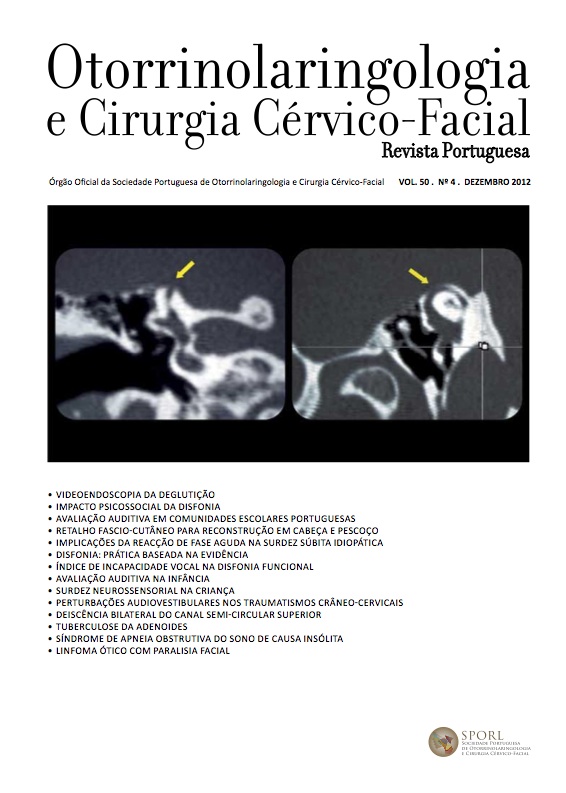Fasciocutaneous radial forearm flap for the reconstruction of surgical defects of head and neck - Clinical experience between 2007 and 2010
DOI:
https://doi.org/10.34631/sporl.59Keywords:
microvascular flaps, radial forearm flap, head and neck oncology, reconstructive techniquesAbstract
Introduction: The authors present their clinical experience in the use of fasciocutaneous forearm flaps for the reconstruction of surgical defects of head and neck.
Material and Methods:It was carried out a revision of the patients submitted to reconstruction of surgical defects of head and neck through microvascularized radial forearm flaps in the past 3 years. A clinical characterization of the patients including age, gender, initial pathology, reconstruction location, complications, and final result was made. Results: Ten patients were studied, aged between 35 and 67 years old, 2 females and 8 males, with head and neck oncological pathology in different stages: 1 spinocellular carcinoma in the submental region; 2 spinocellular carcinomas of the mouth floor; 1 parotid gland mucoepidermoid carcinoma; 1 sublingual gland mucoepidermoid carcinoma ; 2 spinocellular carcinomas of the retromolar trigone; 1 spinocellular carcinoma of the anterior tonsillar pillar and tonsil; and 2 lateral tongue border spinocellular carcinomas. The reconstruction after the tumor exeresis was executed with microvascularized fasciocutaneous radial forearm flap. The final result is good in what concerns the conservation of tongue mobility in the mouth floor reconstructions, and in covering the pharyngeal walls without volume addition or tension for the retromolar trigone defects. The final aesthetics result is satisfactory for the reconstructions of facial cutaneous defects. In the analysis, 20% of failures were observed in consequence of flap necrosis by infection related to osteoradionecrosis in one case and due to flap inviability previously to its application related to vascular thrombosis. Complications of the donor region comprised a case of hematoma of the cutaneous free flap without long term consequences, and two cases of decreased grip strength without limitations in daily activities.
Conclusion: The microvascularized forearm flap is versatile and great for the reconstruction of head and neck defects due to its malleable tissue constitution, of reduce thickness, ideal for maintaining the free mobility of the tissues where is no need to obtain volume. The success of this technique results from the patient general conditions, from the local application conditions, form the experience of the surgeons, being equally necessary the support from a differentiated post-surgical care unit where all the clinical parameters may be optimized owing to the patient stability and flat viability. Guaranteeing these conditions, the described procedures have high success rates with reduced morbidity.
Downloads
References
Chen CM, Lin GT, Fu YC, Shieh TY et al. Complications of free radial forearm flap transfers for head and neck reconstruction. Oral Surg Oral Med Oral Pathol Oral Radiol Endod 2005 Jun;99:671-6
Rinaldo A, Shaha AR, Wei WI, Silver AE et al. Microvascular Free Flaps: a Major Advance in Head and Neck Reconstruction. Acta Otolaryngol 2002; 122: 779–784
Blackwell KE. Unsurpassed Reliability of Free Flaps for Head and Neck Reconstruction. Arch Otolaryngol Head Neck Surg. 1999;125:295-299
Wolff, Hölzle. Radial Forearm Flap. In: - Raising of Microvascular Flaps - A Systematic Approach, Springer-Verlag Berlin Heidelberg 2005: pp1-20
Suh JD, Sercarz JA, Abemayor E, Calcaterra TC et al. Analysis of Outcome and Complications in 400 Cases of Microvascular Head and Neck Reconstruction. Arch Otolaryngol Head Neck Surg. 2004 Aug;130:962-966
Novakovic D, Patel R S, Goldstein DP, Gullane PJ. Salvage of failed free flaps used in head and neck reconstruction. Head & Neck Oncology 2009; 1:33






